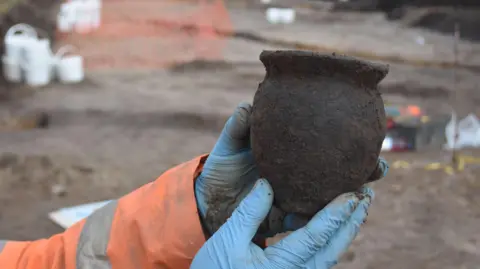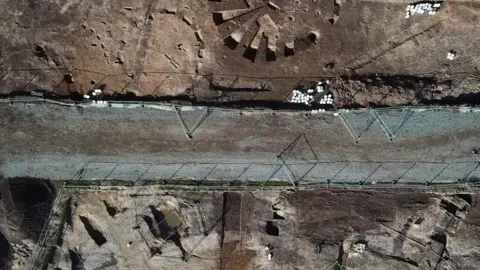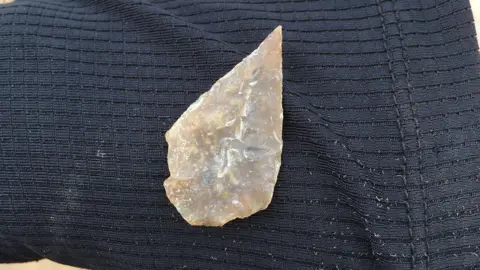Anglo-Saxon finds unearthed at wind farm site
 AOC Archaeology
AOC ArchaeologyArchaeologists have uncovered "significant" Anglo-Saxon finds across Holderness as cables are laid for the Dogger Bank offshore wind farm.
The discoveries include remnants of an Anglo-Saxon long hall structure between Beeford and Skipsea, as well as artefacts from a site in Ulrome.
The findings indicate Anglo-Saxons probably lived and farmed in this landscape over multiple phases between the 5th and 11th centuries.
Community engagement manager for Dogger Bank Wind Farm, Rachel Lawrence, said: "Safeguarding historical evidence has been a critical part of our preparation work on Dogger Bank Wind Farm."
She added: "We’re delighted we’re now able to share these exciting findings with the people who live in the towns and villages where this work was undertaken."
Representatives from the wind farm and AOC Archaeology will present the findings at a public event at Rickaby Village Hall in Ulrome, at 18:00 BST on 20 September.
Archaeologists said artefacts found at their Beeford digs, including pottery and glass beads, indicate Anglo-Saxons settled in Holderness.
Items from the Bronze Age, Iron-Age and Roman period were also found.
 AOC Archaeology
AOC ArchaeologyThe early medieval discoveries were unearthed by archaeologists working on a 30km corridor that houses the underground cables transmitting energy from Dogger Bank Wind Farm in the North Sea to the wind farm’s two onshore stations near Beverley.
Archaeologists described the finds as a "regionally-significant discovery".
Project manager for AOC Archaeology, Rebecca Jarosz- Blackburn, said the most "surprising and rewarding discovery" was the Anglo-Saxon long hall and associated field systems recorded near Beeford, which she said "represents some of the most extensive evidence from the period in the Holderness region".
 AOC Archaeology
AOC ArchaeologyAOC project manager Matt Walker, who grew up in East Yorkshire said one of their main research aims was to "narrow the current date ranges for handmade prehistoric and Roman pottery in the region" by using radiocarbon dating.
"It is the scale of this project across the region, coupled with funding for radiocarbon dates, that gives us a really meaningful opportunity to add to this research theme and advance our understanding of Holderness thousands of years ago," he said.
AOC and Dogger Bank Wind Farm are currently considering options for permanently locating the original artefacts once they have been fully analysed, with a preference to find a home close to where they were unearthed.
 AOC Archaeology
AOC ArchaeologyRickaby Village Hall was chosen for the public even due to its proximity to the wind farm’s landfall point.
A second event is set to be held at a location further along the cable corridor on a date to be confirmed.
An online exhibition is also set to be launched later this year, giving the public access to information about AOC’s work in the East Riding of Yorkshire.
Listen to highlights from Hull and East Yorkshire on BBC Sounds, watch the latest episode of Look North or tell us about a story you think we should be covering here.
